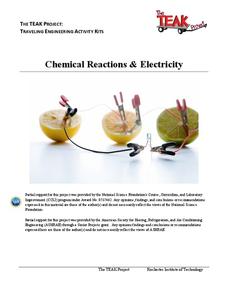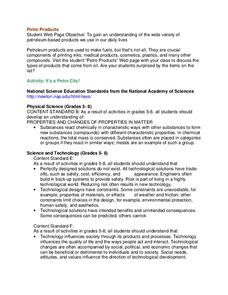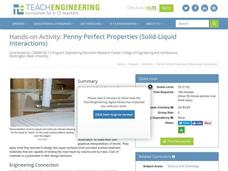Rochester Institute of Technology
Chemical Reactions and Electricity
After a discussion of chemical reactions and electricity, scholars break into groups and follow a scripted activity to discover if fruit can power a clock. After a concluding discussion, the class a presented with a challenge.
Curated OER
Chapter 10: Chemical Calculations and Chemical Equations
In this chemical equations worksheet, students write and balance chemical reactions. They complete 98 short answer and problem solving questions on molarity and chemical equations.
Curated OER
Chemical Elements: Student Story
In this chemical elements: student story worksheet, learners complete the given story by filling in the blanks with the names of the elements in brackets.
Rochester Institute of Technology
Molecules and Fuel Cell Technology
A fuel cell is where the jailer keeps gas guzzlers. Scholars review chemical reactions, chemical bonds, and chemical structure in order to apply these concepts. Participants construct fuel cell kits, using electrolysis to run the car and...
Curated OER
The Mathematics of Ion Rocket Engines
In this ion rocket engines worksheet, students read about how heavy atoms are used to create the thrust in rocket engines. They solve 5 problems including determining the speed of atoms in a satellite, finding the average acceleration of...
Curated OER
The Rates of Chemical Reactions
In this chemistry worksheet, students complete a crossword puzzle with 25 questions on chemical reactions. They identify common terminologies used in describing chemical reactions.
Texas State Energy Conservation Office
Investigation: Crank It Up!
Following this procedure, eager engineers construct a working model of a piston system, similar to that in an internal combustion engine. Perfect for STEM or automotive technology classes, the activity comes complete with analysis and...
Curated OER
Science Quizzes: Engineering Quiz
In this engineering science quiz worksheet, students respond to 10 short answer questions regarding civil, mechanical, electrical, chemical, and aerospace engineering.
Curated OER
Writing the Complete Equation
In this writing equations learning exercise, students are given 6 chemical reactions and they write equations for each one including the reactants, the products and the states of matter.
Teach Engineering
Thirsty for Gold
In the last portion of the six-part unit, teams perform an experiment with gold nanoparticles to determine which sport drink has the most electrolytes. The nanoparticles are used as chemical sensors and fluoresce in different wavelengths...
Curated OER
WS 4.7 Writing Chemical Reactions
In this chemical reactions worksheet, students are given fourteen chemical reactions that they must write using chemical formulas for the reactants and products. They balance each equation by placing the proper coefficients in front of...
Curated OER
Petro Products
In this petroleum products learning exercise, students are given the components of crude oil and they graph the various products found in a 50 gallon barrel. Students complete an activity to determine if they have collected cards that...
Curated OER
Classification of Changes
In this classification of changes worksheet, students identify each example as either chemical or physical changes. Students also classify other examples as either element, compound, solution, colloid, or suspensions. In the other...
Curated OER
Matter and Change
In this matter and change worksheet, students answer 24 questions on topics such as elements, compounds, mixtures and chemical reactions. Students answer questions about the properties of matter such as their physical state and shape. In...
National Center for Case Study Teaching in Science
A Tale of Two Houses
Does it cost more per year to heat Bill's home in North Dakota or to cool Bubba's home in Georgia? Using heat transfer concepts, mathematical equations, and critical thinking skills, young engineers work in groups to determine who is...
Curated OER
More Thermochemistry Problems
This two-page assignment covers basic thermochemistry concepts. Chemistry learners identify exothermic and endothermic processes, explain a phase change graph, and draw an energy level diagram. There are no problems to solve, just...
Teach Engineering
Density and Miscibility
The liquids did not mix — so what do density columns have to do with it? The seventh part in a series of nine provides the theoretical explanation of why density columns do not mix. The lesson covers the topics related to...
Curated OER
Connection to Engineering: Fractions of Crude Oil
In this crude oil worksheet, learners read about the fractions of crude oil and their demand. They answer questions about the data given.
Teach Engineering
Microfluidic Devices and Flow Rate
When you have to flow, you have to flow. The lesson plan introduces class members to microfluidic devices and their uses in medicine. They watch a short video on how the diameter affects the rate of flow. The worksheet has individuals...
Teach Engineering
Penny Perfect Properties (Solid-Liquid Interations)
I can get more water to stay on a penny than you can! Collaborative pairs determine the volume of liquids that can be contained on the surface of copper pennies and plastic coins. The pairs analyze their results using graphs and go on to...
Curated OER
Transition State Theory
For this transition state theory worksheet, students read about chemical reactions and the theory for how chemical reactions proceed. They answer questions about the activated complex, the activation energy and the collision theory all...
Curated OER
Gas Stoichiometry
In this gas stoichiometry worksheet, students use the ideal gas law and balanced chemical equations to solve for unknown values such as volume and mass of gases.
Curated OER
Integrating Space Science-Ion Propulsion in Deep Space I
In this ion propulsion worksheet, students read about Deep Space I that uses ion propulsion to power the spacecraft. They learn about ion propulsion and answer three questions about it.
Curated OER
Magnesium: From Sea Water to Fireworks
In this magnesium instructional activity, students read about how magnesium is extracted from sea water and the different uses of magnesium. Then students complete 4 short answer questions.























